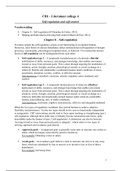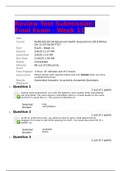Samenvatting
Summary CBI - Literature lecture 4: Self-regulation and self-control
- Instelling
- Universiteit Leiden (UL)
This document entails a detailed summary of the literature for the fourth lecture of the CBI course. It discusses the topics of Self-regulation and self-control. The literature discussed is the following: • Chapter 8 – Self-regulation (O’Donohue & Fisher, 2012). • Chapter 26 – Hel...
[Meer zien]







